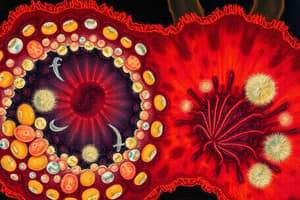Podcast
Questions and Answers
Which organelle is responsible for generating energy through cellular respiration?
Which organelle is responsible for generating energy through cellular respiration?
- Endoplasmic reticulum
- Nucleus
- Ribosomes
- Mitochondria (correct)
What is the function of the Golgi apparatus?
What is the function of the Golgi apparatus?
- Processing, sorting, and packaging of proteins and lipids (correct)
- Protein synthesis
- Energy generation
- Detoxification
Which organelle contains enzymes that break down and recycle waste materials?
Which organelle contains enzymes that break down and recycle waste materials?
- Peroxisomes
- Lysosomes (correct)
- Nucleus
- Endoplasmic reticulum
What is the outer boundary of the cell that separates its interior from its external environment called?
What is the outer boundary of the cell that separates its interior from its external environment called?
What is the function of vacuoles in a cell?
What is the function of vacuoles in a cell?
Where are the endoplasmic reticulum and Golgi apparatus often found within a cell?
Where are the endoplasmic reticulum and Golgi apparatus often found within a cell?
What is one of the functions of cells related to metabolism?
What is one of the functions of cells related to metabolism?
How do cells communicate with each other?
How do cells communicate with each other?
Flashcards are hidden until you start studying
Study Notes
Cell Structure
A cell is the basic unit of life, and it is the smallest unit of a living organism that can carry out all necessary life processes on its own. Cell structure refers to the organization of various components within a cell, which allows it to perform its functions efficiently. In this article, we will explore the cell structure of cells, including their unique features, organization, and functions.
Cell Components
Cells are composed of various components, including:
- Cell membrane: The outer boundary of the cell, which separates the cell's interior from its external environment.
- Cytoplasm: The jelly-like substance inside the cell membrane, which contains various organelles and molecules.
- Nucleus: The central part of the cell that contains the cell's genetic material (DNA) and helps regulate the cell's activities.
- Mitochondria: Organelles that generate energy through a process called cellular respiration.
- Ribosomes: Organelles involved in protein synthesis.
- Endoplasmic reticulum (ER): A network of tubes involved in protein synthesis and lipid synthesis.
- Golgi apparatus: A structure involved in the processing, sorting, and packaging of proteins and lipids.
- Lysosomes: Organelles that contain enzymes that break down and recycle waste materials.
- Peroxisomes: Organelles that contain enzymes involved in the breakdown of fatty acids and detoxification.
- Vacuoles: Membrane-bound compartments that store water and nutrients or help break down waste materials.
- Centrosome: A structure that helps in the movement of cell organelles and the formation of cilia and flagella.
Cell Organization
Cell organization refers to the arrangement of these components within a cell. For example, the nucleus is generally located in the center of the cell, while the mitochondria are found near the cell membrane. The endoplasmic reticulum and Golgi apparatus are often found near the nucleus, while lysosomes and peroxisomes are dispersed throughout the cytoplasm.
Cell Functions
The cell structure allows cells to perform various functions, such as:
- Metabolism: Cells convert nutrients into energy and produce waste products.
- Growth and repair: Cells grow and divide to create new cells or repair damaged tissues.
- Communication: Cells communicate with each other through chemical signals called hormones or neurotransmitters.
- Excretion: Cells eliminate waste products through specialized organelles like lysosomes and peroxisomes.
In conclusion, cell structure plays a crucial role in the functioning of cells. The organization of various components within a cell enables it to carry out its life processes efficiently. Understanding cell structure is essential for understanding the basic principles of biology and the functioning of living organisms.
Studying That Suits You
Use AI to generate personalized quizzes and flashcards to suit your learning preferences.




